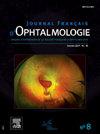【法国白内障手术培训:欧洲眼科委员会法国队列调查结果分析】。
IF 1.2
4区 医学
Q3 OPHTHALMOLOGY
引用次数: 0
摘要
目的:本研究旨在介绍和分析欧洲眼科委员会(EBO)关于欧洲白内障手术培训调查中法国队列的结果,突出法国培训的特殊性。材料与方法:对2018 - 2022年报考EBO的实习生发放一份23题的电子问卷。我们特别收集和分析了法国参与者的回答。结果:122名受访的法国眼科医生平均年龄为31.0±2.8岁,男女平均分布。最常见的患者前培训是虚拟现实模拟器(8.6±8.2次)。法国受访者报告了更高的部分手术(124.1±94.8)和完全手术(96.4±93.1)的平均次数,在进行简单(7.3±2.4)和复杂(5.51±2.6)手术以及处理后囊膜破裂(7.2±2.5)或进行角膜缝合(3.9±2.7)方面的置信度(0-10)增加。讨论:在欧洲范围内,法国白内障手术培训是“全民手术”模式的一部分,没有性别差异。然而,与西班牙和德国等其他欧洲国家相比,地区差异标志着法国的景观。建议将患者前培训课程标准化作为一种均衡手段。结论:为了规范欧洲白内障手术培训,建议制定建议和教育策略,包括患者前培训课程的标准化,以确保手术技能的验证。本文章由计算机程序翻译,如有差异,请以英文原文为准。
Formation à la chirurgie de la cataracte en France : analyse des résultats de l’enquête de l’European Board of Ophthalmology dans la cohorte française
Objectif
Cette étude vise à présenter et analyser les résultats de la cohorte française dans une enquête de l’European Board of Ophthalmology (EBO) sur la formation à la chirurgie de la cataracte en Europe, mettant en lumière les particularités de la formation française.
Matériels et méthodes
Un questionnaire électronique de 23 questions a été envoyé aux internes candidats à l’examen de l’EBO de 2018 à 2022. Les réponses des participants français ont été spécifiquement collectées et analysées.
Résultats
Sur 122 ophtalmologistes français répondants, l’âge moyen était de 31,0 ± 2,8 ans avec une répartition égale entre hommes et femmes. Les séances de formation pré-patient les plus fréquentes étaient sur simulateurs de réalité virtuelle (8,6 ± 8,2 séances). Les répondants français déclaraient un nombre moyen plus élevé de chirurgies partielles (124,1 ± 94,8) et complètes (96,4 ± 93,1), avec une confiance accrue (échelle de 0 à 10) dans l’exécution de chirurgies simples (7,3 ± 2,4) et complexes (5,51 ± 2,6), ainsi que dans la gestion de ruptures capsulaires postérieures (7,2 ± 2,5) ou réalisation de sutures cornéennes (3,9 ± 2,7) par rapport à la moyenne des participants européens.
Discussion
Dans le paysage européen, la formation française en chirurgie de la cataracte s’inscrit dans un modèle de « chirurgie pour tous », sans disparité de genre. Des variations régionales marquent cependant le paysage français, contrastant avec d’autres nations européennes comme l’Espagne ou l’Allemagne.
Conclusion
Pour une harmonisation des formations en chirurgie de la cataracte en Europe, il est conseillé d’établir des recommandations et stratégies éducatives, y compris la standardisation des formations pré-patients pour assurer la validation des compétences chirurgicales.
Objective
This study aims to present and analyze the results of the French cohort in a European Board of Ophthalmology (EBO) survey on cataract surgical training in Europe, highlighting the particularities of French training.
Materials and methods
A 23-question electronic questionnaire was sent to interns applying for the EBO examination from 2018 to 2022. Responses from French participants were specifically collected and analyzed.
Results
Of 122 responding French ophthalmologists, the mean age was 31.0 ± 2.8 years with an equal distribution between men and women. The most frequent pre-patient training sessions were on virtual reality simulators (8.6 ± 8.2 sessions). French respondents reported a higher average number of partial (124.1 ± 94.8) and complete (96.4 ± 93.1) surgeries, with increased confidence (0–10 scale) in performing simple (7.3 ± 2.4) and complex (5.51 ± 2.6) surgeries, as well as in managing posterior capsular ruptures (7.2 ± 2.5) or performing corneal sutures (3.9 ± 2.7).
Discussion
Within the European landscape, French cataract surgery training is part of a model of “surgery for all”, without gender disparity. Regional variations, however, mark the French landscape, in contrast to other European nations such as Spain and Germany. Standardization of pre-patient training sessions is proposed as a means of equalization.
Conclusion
To standardize cataract surgery training in Europe, it is advisable to establish recommendations and educational strategies, including the standardization of pre-patient training sessions to ensure validation of surgical skills.
求助全文
通过发布文献求助,成功后即可免费获取论文全文。
去求助
来源期刊
CiteScore
1.10
自引率
8.30%
发文量
317
审稿时长
49 days
期刊介绍:
The Journal français d''ophtalmologie, official publication of the French Society of Ophthalmology, serves the French Speaking Community by publishing excellent research articles, communications of the French Society of Ophthalmology, in-depth reviews, position papers, letters received by the editor and a rich image bank in each issue. The scientific quality is guaranteed through unbiased peer-review, and the journal is member of the Committee of Publication Ethics (COPE). The editors strongly discourage editorial misconduct and in particular if duplicative text from published sources is identified without proper citation, the submission will not be considered for peer review and returned to the authors or immediately rejected.

 求助内容:
求助内容: 应助结果提醒方式:
应助结果提醒方式:


